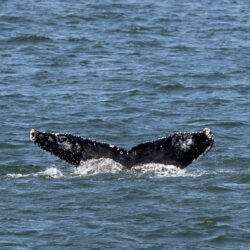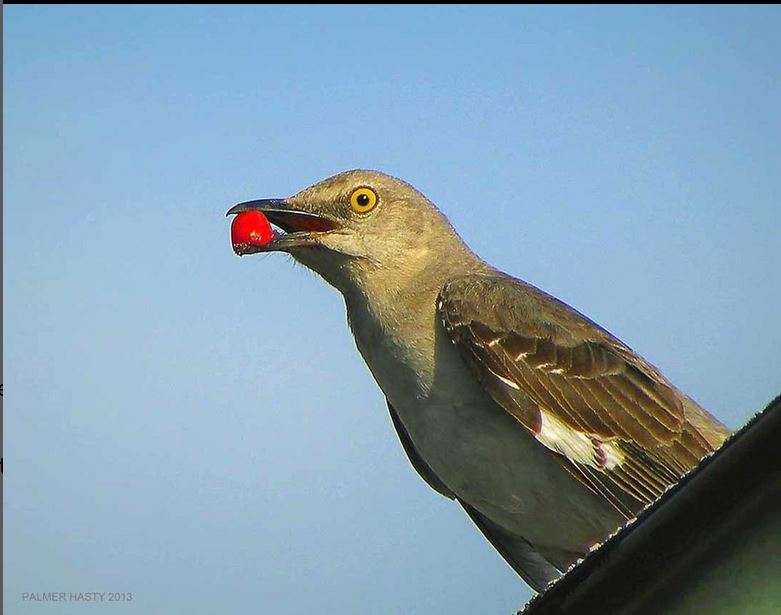A mockingbird with a red berry. Photo: Joseph Palmer, 2012
In this Brooklyn Bird Watch, we’ll share some fascinating facts and theories about the life of birds millions of years ago, and stay tuned for follow-up pieces about the current realities of our fine-feathered friends’ struggle to survive alongside humanity and the environment we have created in the modern world.
If you are a serious birder, or just someone who is merely curious and reads a lot, then you may be fascinated with the fossil evidence that continues to reveal undeniable connections between birds and dinosaurs.
Recall the scene from the movie Jurassic Park (1993) where Sam Neill, playing the part of a paleontologist, reacted to a student’s derision towards Hollywood’s glamorized version of the velociraptor, as looking like an oversized turkey. The cynical kid didn’t see a super dangerous dinosaur, he just saw a big bird.
Back when Jurassic Park was released, there was an increased interest in dinosaurs, and especially the visually obvious link between birds and dinosaurs as revealed in fossils around the world. Many dinosaur fossils were so detailed as to leave the distinct impressions of tail and wing feathers.
Birds Survived, Dinosaurs Did Not
Just the other day, I read an informative article by Smithsonian Magazine Science Correspondent Riley Black, about why, and how, birds survived and dinosaurs did not when the now famous six-mile-wide asteroid crashed into Earth’s surface in the Yucatan a mere 66 million years ago.
Scientifically known as the Cretaceous-Paleogene Extinction Event, scientists say that birds were already dinosaurs. Or put another way, as far back as 150 million years ago, a versatile assortment of dinosaurs had feathers and were essentially what we know of now as “birds.” Some paleontologists also refer to them as “running lizards.”
If you’ve ever watched a Mockingbird swiftly scampering across a concrete courtyard to snatch an insect out of the grass, it might remind you of the Hollywood velociraptors you see in the movies.
Black explains how, immediately following the Yucatan extinction event for the large dinosaurs, the smaller-sized dinosaur-birds put an evolutionary advantage to work, being able to go where larger animals could not to hide and stay safe. These dinosaurs also had the added advantage of beaks, which allowed them to catch insects and gather very small food items that survived the asteroid, like berries and seeds.
Evolution Gave Birds a “Lucky Break”
Black quotes Derek Larson, paleontologist for the Royal BC Museum, “The end of the Cretaceous period boasted an entire array of birds and bird-like reptiles. But of these groups, it was only the beaked birds that survived. The happenstances of evolution had given birds a lucky break, so many of the key events that proved to be evolutionarily advantageous were set in motion long before that asteroid struck 66 million years ago.”
While many of these dinosaur birds had beaks with teeth, the smaller birds also had more flexible diets and, with the ability to fly, maintained an advantage to better find food and shelter during the aftermath of the great catastrophe. This evolutionary development led to the vast, diverse array of beautiful birds we see and share the planet with today.
Birds Are Pretty Smart
As Black explained, “By the end of the Cretaceous period, beaked birds were already eating a much more varied diet than their toothed relatives. These birds weren’t specialized on insects or other animal food, and so they were able to pluck up hard food items like seeds and nuts. And in the aftermath of the extinction, when animal life was severely cut back, those hard, persistent little morsels got beaked birds through the hard times.
Beaked birds were able to feed on the seeds of the destroyed forests and wait out the decades until vegetation began to return. The genetic relationships revealed through fossils and the timeline of bird evolution show that early members of modern bird groups – such as birds related to ducks, parrots, and chickens – were around by the time the asteroid struck. These bird groups, of course, suffered losses but enough survived to set up a new pulse of bird evolution in the millions of years following the catastrophe.”
What also happened was that many of the bird lineages became smaller in size, yet inexplicably, they maintained their brain size, resulting in a situation where many of the “shrinking birds” wound up with larger brains compared to body size, therefore, setting the stage for avian intelligence beyond what the non-avian dinosaurs could have evolved.
A quick word about beaks: The critical and multifunctional role beaks have played in bird evolution is absolutely paramount to the fascinating survival of birds throughout diverse environments. The evolution of beaks demonstrates how a single structure can be modified in countless ways to suit a species’ needs, highlighting the dynamic nature of evolution in action.
The unmistakable and often mysterious connection between dinosaurs and birds, as recorded in the fossil record, continues to have an obvious educational value for students and science, while simultaneously being a source of endless fascination for the general public.

✰PREMIUM
Brooklyn ‘Climate Pitch’ contest highlights five startup companies
October 28 |
Wayne Daren Schneiderman

Rising vessel traffic fuels humpback mortalities in New York waters
October 5 |
Alex Streinger, Columbia News Service

✰PREMIUM
Under the K Bridge: Concrete in bloom
September 26 |
Joey Pozo

WindScape Brooklyn celebrates opening in Sunset Park
September 24 |
Jaime DeJesus


